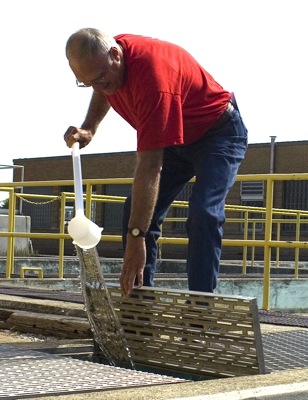Friday, August 29th, 2008
Water under the bridge
Retiring Celina water treatment plant worker says water and city's reputation now clean
By William Kincaid

Photo by Mark Pummell/The Daily Standard
Larry Derksen - who describes himself as the quintessential baby boomer - said he is proud of the commitment made by multiple Celina city officials and operators over the year whose efforts led to a change in the water quality. Derksen will retire Sept. 1 after working 30 years at the city's water treatment plant.
After three decades of work as an operator at the Celina water treatment plant, Larry Derksen is happy to say the reputation of the city utilities has improved.
Back in the day, Derksen said the mere mention of Celina brought to mind two thoughts: terrible, fetid water and the doomed Blue Goose power plant.
"That was Celina right there," said Derksen, who officially retires on Sept. 1.
But after years of progress, the water quality is as good as it's going to get and the notorious goose has been plucked of its last ill-fated feathers, he said.
"It took 30 years to get to this point," Derksen said about Celina's water, which he believes went from the worst to the best in the state after the recent completion of the new facility.
The 60-year-old Derksen - who describes himself as the quintessential baby boomer - said he is proud of the commitment made by multiple city officials and operators over the years whose efforts led to the change in the water quality.
Celina's $6 million water treatment facility project - which adds granular activated carbon (GAC) filtration to the city's existing treatment process - is completely online now.
Each tank contains 40,000 pounds of carbon that absorbs the organic content, removing it from the city water drawn from Grand Lake. Organic materials react with chlorine over time to form trihalomethanes (THMs), which lab tests have linked to some forms of cancer and other diseases.
"I think everyone should see that (new) facility and be proud of it," he said. "We've got a heck of a water treatment plant down there now."
The drawn out process of cleaning up the water - which included listening to grumbling residents, substantial money, bold decisions and what Derksen believes is the most important virtue, patience - started in 1975.
At that time, Derksen said the city began adding carbon to the water to modify the overwhelming, dead-fish odor of the water. But the efforts barely put a dent in the water odor, he said.
The water was not significantly improved again until 1995 when the city began adding ozone to the water - a million dollar project that Derksen said took guts on the part of city officials at the time.
Derksen said ozone gas is derived from oxygen on site and used to oxidize some of the odor-producing organics, breaking them down into smaller molecules.
It was a significant improvement, Derksen said, pointing out that the Celina plant was only one of two in the state to use ozone, a highly-unstable triatomic molecule with three oxygen atoms.
The final step came in the last few years as city officials were mandated by the Ohio EPA to lower the excessive amounts of THM or face substantial fines.
Derksen also reminisced about his time at the plant, pointing out the particularly cold winter of 1979. In December of that year, temperatures dropped below zero for an entire week, reaching as low as minus 20 degrees.
"Everything just froze up solid," Derksen said, including numerous customer service lines.
For two weeks, many residents were without water, he said. City officials employed a variety of methods, including hiring a private welder to thaw the lines.
"You talk about some irritated people - if you're name was on the list (of frozen lines), there's nothing you could do," he said. "That was worse than the blizzard."
Derksen also is proud of his fellow operators and their work. Celina citizens have never had to boil their water because of an incident or error at the plant. Citizens only boiled water when a water main broke, which is required by law, he said.
Derksen and his wife, JoAnn, now plan on traveling and spending time with their four children, all college graduates who are dispersed throughout the U.S.
"They have plans for me, I don't have any. I'm proud of every one of them; they did so good," he said.
One is an optometrist, another is a controller of a national company, another is involved in marketing and another is a computer animator for a motion picture company, he said.
When asked about his decision to retire, Derksen said he wants to enjoy the rest of his life, pointing out one of his co-workers died on the job six months before his retirement.
"I still got my health. There's no sense working until you're dead on the job," he said.
Before working at the plant, Derksen was in the U.S. Air Force and worked as a handyman at the former New Idea plant in Coldwater, moving from the press room to assembly, to the warehouse, to mounting tires and other jobs.
It was a difficult time, continually moving around and occasionally laid off while tending to his family, he explained
"You play the cards that are dealt to you - that's the way I look at life," he said.
He was hired by the Celina water treatment plant on May 9, 1977 - a day that is forever branded in his head, he said.
"I knew what water treatment plant work was like," he said, adding that when he was 11 years old he visited his grandfather, who also worked at a water treatment plant in Kenton.
"It's been fun, I'd do it again," he said, except for having to work every other weekend.

Photo by Mark Pummell/The Daily Standard
Retiring Celina Water Treatment Plant employee Larry Derksen uses a ladle to dip water from a settling lagoon at the plant this week.



